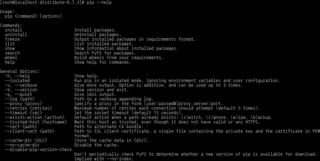The Comprehensive Perl Archive Network (CPAN) is a repository of over 250,000 software modules and accompanying documentation for 39,000 distributions, written in the Perl programming language by over 12,000 contributors. CPAN can denote either the archive network or the Perl program that acts as an interface to the network and as an automated software installer. Most software on CPAN is free and open source software.

Ruby is an interpreted, high-level, general-purpose programming language which supports multiple programming paradigms. It was designed with an emphasis on programming productivity and simplicity. In Ruby, everything is an object, including primitive data types. It was developed in the mid-1990s by Yukihiro "Matz" Matsumoto in Japan.

BioRuby is a collection of open-source Ruby code, comprising classes for computational molecular biology and bioinformatics. It contains classes for DNA and protein sequence analysis, sequence alignment, biological database parsing, structural biology and other bioinformatics tasks. BioRuby is released under the GNU GPL version 2 or Ruby licence and is one of a number of Bio* projects, designed to reduce code duplication.

In software development, a README file contains information about the other files in a directory or archive of computer software. A form of documentation, it is usually a simple plain text file called README, Read Me, READ.ME, README.TXT, README.md, or README.1ST.

Arch Linux is an independently developed, x86-64 general-purpose Linux distribution that strives to provide the latest stable versions of most software by following a rolling-release model. The default installation is a minimal base system, configured by the user to only add what is purposely required.

Ruby on Rails is a server-side web application framework written in Ruby under the MIT License. Rails is a model–view–controller (MVC) framework, providing default structures for a database, a web service, and web pages. It encourages and facilitates the use of web standards such as JSON or XML for data transfer and HTML, CSS and JavaScript for user interfacing. In addition to MVC, Rails emphasizes the use of other well-known software engineering patterns and paradigms, including convention over configuration (CoC), don't repeat yourself (DRY), and the active record pattern.
JRuby is an implementation of the Ruby programming language atop the Java Virtual Machine, written largely in Java. It is free software released under a three-way EPL/GPL/LGPL license. JRuby is tightly integrated with Java to allow the embedding of the interpreter into any Java application with full two-way access between the Java and the Ruby code.
Rubinius is an alternative Ruby implementation created by Evan Phoenix. Based loosely on the Smalltalk-80 Blue Book design, Rubinius seeks to "provide a rich, high-performance environment for running Ruby code."
A software repository, or repo for short, is a storage location for software packages. Often a table of contents is also stored, along with metadata. A software repository is typically managed by source or version control, or repository managers. Package managers allow automatically installing and updating repositories, sometimes called "packages".
Haml is a templating system that is designed to avoid writing inline code in a web document and make the HTML cleaner. Haml gives you the flexibility to have some dynamic content in HTML. Similar to other template systems like eRuby, Haml also embeds some code that gets executed during runtime and generates HTML code in order to provide some dynamic content. In order to run Haml code, files need to have a .haml extension. These files are similar to .erb or .eRuby files, which also help embed Ruby code while developing a web application.

Shoes is a GUI toolkit based on the Ruby programming language. It was originally developed by Jonathan Gillette, and others are carrying on with it after his disappearance. Shoes runs on Microsoft Windows, Mac OS X and Linux (GTK+), using the underlying technologies of Cairo and Pango.
QtRuby is a binding of the application framework Qt for Ruby. Korundum is an additional set of bindings for KDE which extend QtRuby.

Nokogiri is an open source software library to parse HTML and XML in Ruby. It depends on libxml2 and libxslt to provide its functionality.

Homebrew is a free and open-source software package management system that simplifies the installation of software on Apple's operating system, macOS, as well as Linux. The name is intended to suggest the idea of building software on the Mac depending on the user's taste. Originally written by Max Howell, the package manager has gained popularity in the Ruby on Rails community and earned praise for its extensibility. Homebrew has been recommended for its ease of use as well as its integration into the command-line interface. Homebrew is a member of the Open Source Collective, and is run entirely by unpaid volunteers.

npm is a package manager for the JavaScript programming language maintained by npm, Inc. npm is the default package manager for the JavaScript runtime environment Node.js and is included as a recommended feature in the Node.js installer.

pip is a package-management system written in Python and is used to install and manage software packages. The Python Software Foundation recommends using pip for installing Python applications and its dependencies during deployment. Pip connects to an online repository of public packages, called the Python Package Index. Pip can be configured to connect to other package repositories, provided that they comply to Python Enhancement Proposal 503.
LuaRocks is a package manager for the Lua programming language that provides a standard format for distributing Lua modules, a tool designed to easily manage the installation of rocks, and a server for distributing them. While not included with the Lua distribution, it has been called the "de facto package manager for community-contributed Lua modules".

Composer is an application-level dependency manager for the PHP programming language that provides a standard format for managing dependencies of PHP software and required libraries. It was developed by Nils Adermann and Jordi Boggiano, who continue to manage the project. They began development in April 2011 and first released it on March 1, 2012. Composer is strongly inspired by Node.js's "npm" and Ruby's "bundler". The project's dependency solving algorithm started out as a PHP-based port of openSUSE's libzypp SAT solver.
CocoaPods is an application level dependency manager for Objective-C, Swift and any other languages that run on the Objective-C runtime, such as RubyMotion, that provides a standard format for managing external libraries. It was developed by Eloy Durán and Fabio Pelosin, who continue to manage the project with the help and contributions of many others. They began development in August 2011 and made the first public release on September 1, 2011. CocoaPods is strongly inspired by a combination of the Ruby projects RubyGems and Bundler.
Apotomo is a platform-specific widget framework for Ruby on Rails, designed to simplify the components and code of the view section of the MVC design pattern. Apotomo is built on, and was built by the same engineer as, the Cells Project.










